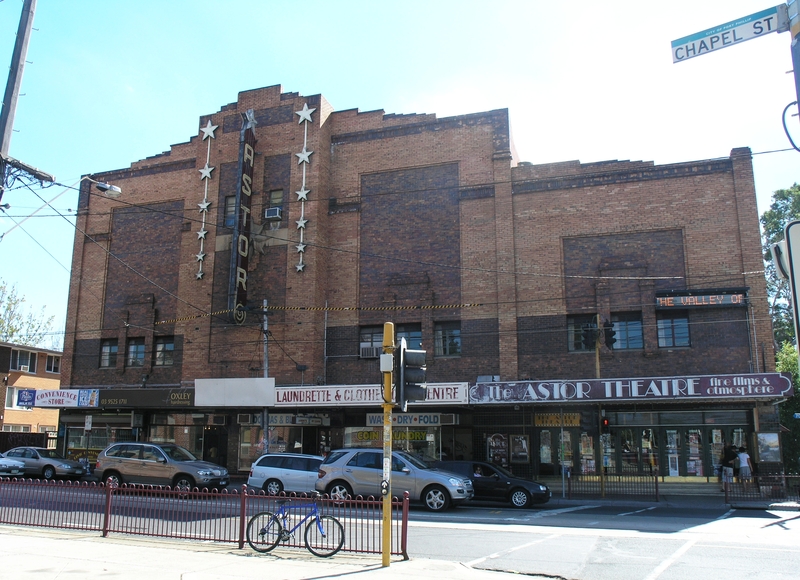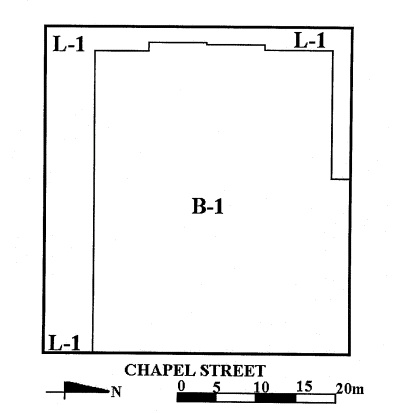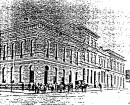THE ASTOR THEATRE
1-9 CHAPEL STREET ST KILDA, PORT PHILLIP CITY
-
Add to tour
You must log in to do that.
-
Share
-
Shortlist place
You must log in to do that.
- Download report





Statement of Significance
WHAT IS SIGNIFICANT?
The Astor Theatre, designed by architect Ron Morton Taylor, was built by the contractors Clements Langford in 1935-36. It was officially opened on 3 April 1936 at a ceremony attended by the mayor and councillors of St Kilda and a large number of invited guests. The theatre is in the Jazz Moderne style with distinctive brickwork on the facade in cream and dark brown. Its facade includes a stepped parapet wall, a projecting bay flanked by three large recessed panels with casement windows, and a cantilevered awning with pressed metal ceiling. The projecting bay features an eight point star in bas relief with an illuminated neon sign and flanked by twelve illuminated, ascending stars. Beneath the theatre awning are four shopfronts and the theatre entrance. The side walls are red brick and the roof is corrugated iron.
HOW IS IT SIGNIFICANT?
The Astor Theatre has architectural, historical, social and scientific
significance to the state of Victoria.
WHY IS IT SIGNIFICANT?
The Astor Theatre is architecturally significant as a highly intact, rare survivor of a Jazz Moderne, or Art Deco, style cinema. The Art Deco style was the predominant design of cinemas during the 1930s, but the Astor is one of only a small group of intact cinemas surviving from this period. It is also one of the earliest and most important examples of the suburban Art Deco cinemas. The exterior is relatively restrained in its decorative treatment, featuring distinctive brickwork, a stepped parapet and a neon sign. The interior includes important decorative details such as the entrance foyer with its terrazzo floor, staircase with wrought iron balustrade and polished timber handrail, and the distinctive spatial sequence of the foyers with the elliptical open well with fine chevron pattern friezes in wrought iron linking the ground floor foyer with the upstairs foyer, tiered ceilings, and characteristic Jazz Moderne foyer and auditorium decoration. It is a fine example of the work of the architect Ron Morton Taylor who had been a partner in the prominent firm of cinema architects Bohringer, Taylor and Johnson responsible for the design of the State Theatre, Flinders Street, Melbourne.
The Astor has historical and social significance for its associations with perhaps the most important mass entertainment of the twentieth century, the cinema. The scale of the theatre and the quality of its decoration evoke the popularity and glamour of cinema as entertainment, particularly during the heyday of cinema in the 1930s. The Astor Theatre, with its Moderne design, spacious foyers and its many original furnishings, objects and surviving early signage, symbolises the suburban cinema experience during the inter-war years when cinema-going reached its peak. The use of the theatre for Greek language films from 1969 until 1982 has associations with an important aspect of post-war life and demonstrates the impact of migration on Australian society.
The Astor Theatre is of historical and scientific significance for its collection of fixtures, fittings and movable objects which assist in an understanding of the history and development of film technology, including the original screen threaded on its frame still in situ, a 1929 Western Electric amplifier, original projector and original lighting rack.
-
-
THE ASTOR THEATRE - Permit Exemptions
General Exemptions:General exemptions apply to all places and objects included in the Victorian Heritage Register (VHR). General exemptions have been designed to allow everyday activities, maintenance and changes to your property, which don’t harm its cultural heritage significance, to proceed without the need to obtain approvals under the Heritage Act 2017.Places of worship: In some circumstances, you can alter a place of worship to accommodate religious practices without a permit, but you must notify the Executive Director of Heritage Victoria before you start the works or activities at least 20 business days before the works or activities are to commence.Subdivision/consolidation: Permit exemptions exist for some subdivisions and consolidations. If the subdivision or consolidation is in accordance with a planning permit granted under Part 4 of the Planning and Environment Act 1987 and the application for the planning permit was referred to the Executive Director of Heritage Victoria as a determining referral authority, a permit is not required.Specific exemptions may also apply to your registered place or object. If applicable, these are listed below. Specific exemptions are tailored to the conservation and management needs of an individual registered place or object and set out works and activities that are exempt from the requirements of a permit. Specific exemptions prevail if they conflict with general exemptions. Find out more about heritage permit exemptions here.Specific Exemptions:EXEMPTIONS FROM PERMITS:
(Classes of works or activities which may be undertaken without a permit under
Part 4 of the Heritage Act 1995)
General Conditions:
1. All exempted alterations are to be planned and carried out in a manner which prevents damage to the fabric of the registered place or object.
2. Should it become apparent during further inspection or the carrying out of alterations that original or previously hidden or inaccessible details of the place or object are revealed which relate to the significance of the place or object, then the exemption covering such alteration shall cease and the Executive Director shall be notified as soon as possible.
3. If there is a conservation policy and plan approved by the Executive Director, all works shall be in accordance with it.
4. Nothing in this declaration prevents the Executive Director from amending or rescinding all or any of the permit exemptions.
5. Nothing in this declaration exempts owners or their agents from the responsibility to seek relevant planning or building permits from the responsible authority where applicable.
Exterior:
* Minor repairs and maintenance which replace like with like.
* Removal of extraneous items such as air conditioners, pipe work, ducting, wiring, antennae, aerials etc and making good.
* Installation or repair of damp proofing by either injection method or
grouted pocket method.
Interior:
* Public spaces: Painting of previously painted walls and ceilings in colour schemes consistent with paint schemes of the 1930s period provided that preparation or painting does not remove evidence of the original paint or other decorative schemes.
* Service spaces: Painting of previously painted walls and ceilings provided that preparation or painting does not remove evidence of the original paint or other decorative schemes.
* Removal of paint from originally unpainted or oiled joinery, doors and skirtings.
* Installation, removal or replacement of carpets and/or flexible floor
coverings.
* Installation, removal or replacement of curtain track, rods, blinds and other window dressings.
* Installation, removal or replacement of hooks, nails and other devices for the hanging of mirrors, paintings and other wall mounted artworks.
* Refurbishment of bathrooms, toilets including removal, installation or replacement of sanitary fixtures and associated piping, mirrors, wall and floor coverings.
* Installation, removal or replacement of kitchen benches and fixtures including sinks, stoves, ovens, refrigerators, dishwashers etc and associated plumbing and wiring.
* Installation, removal or replacement of ducted, hydronic or concealed radiant type heating provided that the installation does not damage existing skirtings and architraves and provided that the location of the heating unit is concealed from view.
* Installation, removal or replacement of electrical wiring provided that all new wiring is fully concealed and any original light switches, pull cords, push buttons or power outlets are retained in-situ. Note: if wiring original to the place was carried in timber conduits then the conduits should remain in-situ.
* Installation, removal or replacement of bulk insulation in the roof space.
* Installation, removal or replacement of smoke detectors.
-
-
-
-
-
PRAHRAN TOWN HALL
 Victorian Heritage Register H0203
Victorian Heritage Register H0203 -
FORMER POLICE STATION AND COURT HOUSE
 Victorian Heritage Register H0542
Victorian Heritage Register H0542 -
FORMER PRIORY LADIES SCHOOL
 Victorian Heritage Register H0726
Victorian Heritage Register H0726
-
"1890"
 Yarra City
Yarra City -
"AMF Officers" Shed
 Moorabool Shire
Moorabool Shire -
"AQUA PROFONDA" SIGN, FITZROY POOL
 Victorian Heritage Register H1687
Victorian Heritage Register H1687
-
1 Fordham Court
 Yarra City
Yarra City -
10 Fordham Court
 Yarra City
Yarra City
-
-















